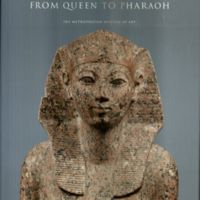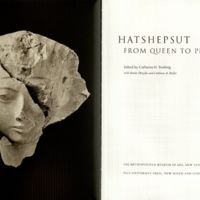Hatshepsut: from Queen to Pharaoh
Dublin Core
Title
Hatshepsut: from Queen to Pharaoh
Description
The female pharaoh Hatshepsut reigned for nearly twenty years during Egypt's early New Kingdom in the fifteenth century B.C. First acting as regent for her young nephew/stepson Thutmose III, she in time assumed the title of king and exercised the full powers of the throne as senior co-ruler. In accordance with Egyptian tradition, Hatshepsut was often depicted as a male king. After her death, however, monuments bearing her image were ruthlessly defaced, and her name was erased from historical accounts. Hatshepsut's rise to power and the nature of her kingship have long been debated by scholars. This fascinating period, one of immense artistic creativity, is illuminated by this volume's rich presentation of monumental royal sculpture and reliefs, ceremonial objects, exquisite personal items for everyday use, and dazzling jewelry. Essays focus on influences from the neighboring Near East, Nubia, and the Aegean; the innovative architecture built by Hatshepsut; powerful figures in the royal court during her reign; archaeological finds from this period; and mysteries surrounding the destruction of Hatshepsut's statues and the obliteration of her name. The first in-depth treatment of the subject, Daughter of Re is an important investigation into the impact of Hatshepsut's reign on the history, culture, and artistic output of Egypt. ... Publisher description.
Publisher
New York : The Metropolitan Museum of Art ; New Haven : Yale University Press
Contributor
Edited by Catharine H. Roehrig with Renée Dreyfus and Cathleen A. Keller
Table Of Contents
Models of authority: Hatshepsut's predecessors in power -- The burial of a royal woman and child of the late seventeenth dynasty -- Art in transition: the rise of the eighteenth dynasty and the emergence of the Thutmoside style in sculpture and relief -- Painting in the early eighteenth dynasty -- Egypt and Nubia: conflict with the kingdom of Kush -- Egypt and the near east: evidence of contact in the material record -- Glass -- The tomb of Maiherperi in the Valley of the Kings -- Egypt and the Aegean: cultural convergence in a Thutmoside palace at Avaris -- The role of Amun -- Hatshepsut: princess to queen to co-ruler -- The tomb of Ramose and Hatnefer -- The joint reign of Hatshepsut and Thutmose III -- The royal court -- The career of Senenmut -- Senenmut, royal tutor to princess Neferure -- The statuary of Senenmut -- The tombs of Senenmut -- The temple of Hatshepsut at Deir el-Bahri -- Foundation deposits for the temple of Hatshepsut at Deir el-Bahri -- Hatshepsut's mortuary temple at Deir el-Bahri: architecture as political statement -- The statuary of Hatshepsut -- The shrines to Hathor at Deir el-Bahri -- The temple of Mut: new evidence on Hatshepsut's building activity -- The two tombs of Hatshepsut -- Jewelry in the early eighteenth dynasty -- Cosmetic equipment -- Pottery and stone vessels in the reign of Hatshepsut and Thutmose III -- Figure vases -- Animal vases -- Metalwork -- Furniture and carpentry -- After Hatshepsut: the military campaigns of Thutmose III -- The proscription of Hatshepsut -- The destruction of the statues of Hatshepsut from Deir el-Bahri -- Erasing a reign -- The temple of Thutmose III at Deir el-Bahri -- A chronology: the later history and excavations of the temple of Hatshepsut at Deir el-Bahri -- Hatshepsut's reputation in history.
Text Item Type Metadata
Original Format
Book
Citation
“Hatshepsut: from Queen to Pharaoh,” Humanities Hub, accessed December 29, 2025, https://humanitieshub.sdsu.edu/omeka/items/show/1390.


